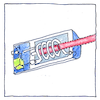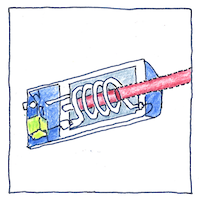Albert Einstein, Charles Hard Townes, James P. Gordon, Theodore Harold Maiman
physics

|
Stimulated emission
Studying Max Planck’s law of radiation, Albert Einstein made the theoretical discovery of the stimulated emission of radiation, which led to the development of lasers and masers. An electron energized in a field may drop to a lower energy level and emit a photon with the same direction, phase, frequency, and polarity of the other photons in the field.
Masers and lasers
In 1953, the colleagues of Charles Hard Townes told him that it wouldn’t work, but he and James P. Gordon built the first working maser using stimulated emission of ammonia molecules to amplify microwaves. In 1960, to construct the first laser, Theodore Harold Maiman had to increase the frequency of the maser fifty thousand times. Now there are thousands of masers and lasers; there are lasers and masers for every part of the spectrum.
Theoretically possible
1. Kurt Gödel proved time travel is possible. Why not table-top fusion and antigravity? Why not create a weapon that disables only other weapons? How about a gun that shoots a web to disable a man without harming him? How about a portable X-ray microscope to trace disease vectors through an ecosystem? How about a glue that rejoins bones, and a salve to restore lost hearing? How about a lotion that cures cancer and prevents disease? How about developing a hardy bush that easily grows a variety of fruit, grain, and vegetables? How about speeding the growth of trees to raise a giant oak in a month? How about a comfortable garment that shades and warms in any weather? How about creating world peace and improving relations between people? 2. It’s theoretically possible to know what you’re thinking, but could everyone be given a means to help in understanding each other? And how could we prevent people from abusing this ability? Would it be any easier to educate people so they appreciate poetry?



Masers and lasers have thousands of uses, such as in barcode scanners, CD players, laser printers, laser pointers, welding and cutting, and eye surgery. The International Bureau of Weights and Measures uses a hydrogen maser as an atomic frequency standard. Masers occur naturally in space, even in the tails of comets.
See also in The book of science:
Readings in wikipedia: